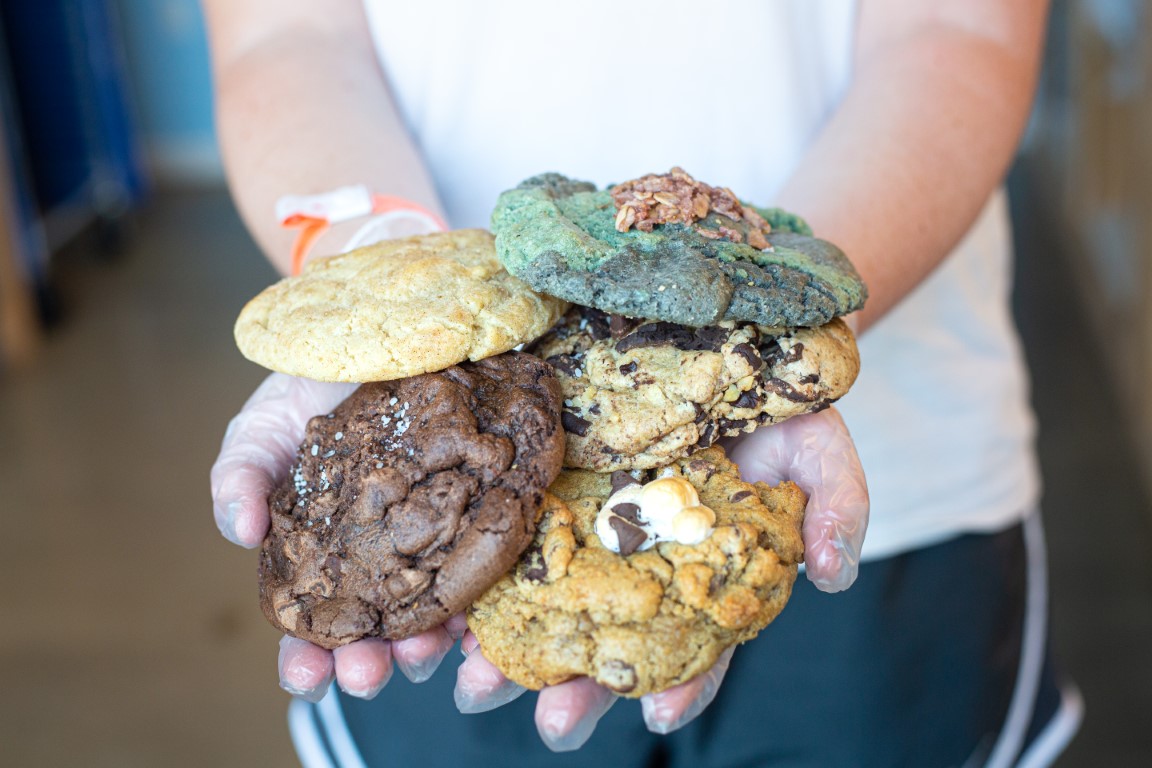You can bake cookies on aluminum foil, and it offers benefits like even heat distribution and a natural non-stick surface. However, cookies brown quicker on foil, so watch out for overbrowning. Reduce your oven temperature slightly and keep an eye on baking times. It's important to handle the foil carefully since it's less sturdy than a traditional baking sheet. Greasing the foil can help prevent sticking. If you're aiming for crispier bottoms and softer centers, foil might be perfect. Curious about how to make your cookies bake perfectly on foil and other alternatives? You're about to uncover more revelations.
Key Takeaways
- Yes, you can bake cookies on aluminum foil, which offers excellent heat conduction.
- Aluminum foil's natural non-stick surface aids in easy cookie removal.
- Monitor baking time closely as cookies may cook faster on foil.
- Adjust oven temperature down by 10-15 degrees Fahrenheit to prevent overbrowning.
- Lightly grease foil or use non-stick spray to prevent cookies from sticking.
Understanding Baking Surface Options
When you're deciding on a baking surface for cookies, aluminum foil is a popular choice, but it comes with both benefits and drawbacks. It can impact how your cookies brown and their overall texture, so understanding these effects is essential for the perfect bake. Let's explore how using foil might change your cookie game.
Pros and Cons of Aluminum Foil for Cookie Baking
Opting for aluminum foil as a baking surface for cookies offers both advantages and drawbacks that are worth considering. Aluminum foil is a convenient alternative to a traditional baking sheet. It's known for its excellent conduction of heat, which guarantees even heat distribution across your cookies. This can result in a more consistent bake. Additionally, aluminum foil provides a natural non-stick coating, making it easier to remove cookies without leaving a mess behind.
However, the thinness of aluminum foil can sometimes cause cookies to bake faster, which might lead to overbrowning if you're not vigilant. Also, foil isn't as sturdy as a baking sheet, so handling can be tricky. Ultimately, whether you choose foil depends on your baking preferences and priorities.
How Aluminum Foil Affects Cookie Texture and Browning
Understanding how aluminum foil affects cookie texture and browning can help you make informed decisions about your baking surface. When you bake cookies on aluminum foil, remember that foil is an excellent conductor of heat. This means that the aluminum foil heat can cause your cookie bottoms to brown faster than the tops. You might notice a crisper texture on the bottoms, which some people prefer for certain types of cookies.
However, if you're aiming for a uniform cookie texture, foil might cause uneven results. The increased heat on the bottom can lead to cookies with a softer center and crispier edges. To balance this, keep a close eye on your cookies and consider adjusting baking times. Experimentation helps in achieving the desired balance of texture and browning.

Choose Your Own Delightfully Perfect Cookies.
With almost 30 flavors to choose from, you can make your box as unique as you are.
Best Practices for Baking With Aluminum Foil
Before you start baking cookies on aluminum foil, make sure to properly prepare the foil by lightly greasing it to prevent sticking. You might need to adjust your oven temperature and baking time slightly, as foil can conduct heat differently than a baking sheet. Keep an eye on your cookies to avoid over-browning or burning.
Proper Foil Preparation Techniques
When baking cookies on aluminum foil, a few key preparation techniques can make all the difference. Start by laying a sheet of aluminum foil tightly across your baking sheet. This creates a smooth cooking surface, perfect for even baking. Aluminum foil acts as an excellent heat conductor, distributing heat evenly across your cookies. To prevent sticking, lightly grease the foil with cooking spray or butter, ensuring your cookies slide right off without leaving crumbs behind. This simple step is your cookie baking secret weapon, helping you avoid messy grease splatters. Remember to fold the edges of the foil slightly, creating a barrier that keeps cookies from slipping off. With these techniques, you'll achieve perfectly baked cookies every time.
Temperature and Timing Adjustments
Baking cookies on aluminum foil requires some adjustments to your usual temperature and timing to guarantee the best results. When using aluminum foil, the heat flow can be more direct, which may cause the bottoms of your cookies to brown faster. To counter this, you might want to lower your oven temperature by about 10-15 degrees Fahrenheit. This helps assure even baking and prevents over-browning.
Additionally, keep a close eye on the cooking time. Baking cookies on foil could mean they cook a minute or two quicker than on a traditional baking sheet. Start checking for doneness a few minutes earlier than your recipe suggests. By monitoring oven temperature and adjusting cooking time, you'll achieve perfectly baked cookies with ideal texture and flavor.
Alternative Cookie Baking Surfaces
When exploring alternative surfaces for baking cookies, consider the benefits of parchment paper and silicone baking mats. Parchment paper provides a non-stick surface and easy cleanup, while silicone mats offer durability and even heat distribution. Choose parchment for quick baking and silicone mats for repeated use and consistent results.
Benefits of Parchment Paper
Opting for parchment paper as an alternative baking surface offers numerous advantages. When you use parchment paper, your cookie dough doesn't stick to the pan, making it easier to remove the cookies once they're baked. This is especially beneficial for cookie recipes that tend to spread, ensuring your chewy cookies maintain their shape. Parchment paper cookies bake evenly, as the paper helps distribute heat more uniformly. Plus, cleanup is a breeze; just toss the paper when you're done. You won't need to grease your baking sheets, which means less fat in your treats. Parchment paper also provides a barrier that prevents cookies from burning on the bottom. It's a simple switch that enhances both the baking process and the final product.
Advantages of Silicone Baking Mats
Although parchment paper is a popular choice, silicone baking mats offer several unique advantages that might make them your new favorite baking surface. Silicone mats are fantastic alternatives to aluminum foil because they eliminate the need for greasing, ensuring your cookies don't stick. They're not only non-stick but also provide a smooth, even surface that helps distribute heat uniformly. This means your cookies bake consistently without the risk of burning from direct contact with a hot pan. These mats are excellent heat conductors, which helps achieve that perfect golden-brown finish. Plus, silicone baking mats are reusable, reducing waste and saving you money over time. Cleaning up is a breeze; just wipe them down or toss them in the dishwasher for convenience.
When To Use Each Option
Choosing the right baking surface can make a big difference in your cookie-baking experience. If you're using a cookie sheet, it's great for even heat distribution, giving your cookies a uniform bake. Opt for a foil-lined baking sheet when you want easy cleanup and a slightly crispier bottom. Aluminum foil is handy for those times when you need a quick solution and don't mind a bit of extra cleanup. Baking dishes are excellent for bar cookies or deeper treats.
Here's when to use each option:
- Cookies on parchment: Ideal for delicate cookies that might stick.
- Foil-lined baking sheet: Perfect for crispy edges.
- Baking dish: Use for thick, chewy bar cookies.
Experiment with each surface to find your perfect cookie texture!
Troubleshooting Common Issues
When baking cookies on aluminum foil, you might encounter a few common issues, but they're easy to tackle. To prevent cookies from sticking, you can lightly grease the foil or use a quick spray of non-stick cooking spray. If you're facing uneven baking or excessive cookie spread, try adjusting the oven temperature or spacing the dough a bit further apart.
Preventing Cookies From Sticking
To keep your cookies from sticking to aluminum foil, proper preparation is key. First, make certain your foil-lined sheets are ready for easy release. Here's how you can do it:
- Use non-stick spray: Lightly coat the aluminum foil with a non-stick spray before placing the dough. This creates a barrier between the cookies and the foil, reducing sticking.
- Add a thin layer of flour: Dusting a small amount of flour over the foil can help prevent cookies from gripping the surface during baking.
- Chill your dough: Cold dough is less likely to spread excessively and stick. Keep it in the fridge for a bit before baking.
Avoiding Uneven Baking
While preventing cookies from sticking to aluminum foil is important, guaranteeing they bake evenly is just as essential for achieving perfect results. Uneven baking can lead to cookies that are crispy on one side and undercooked on the other. To avoid this, start by evenly spreading the dough on the foil on baking trays. Use consistent portions, so each cookie bakes at the same rate. In a conventional oven, hot spots can cause uneven baking. Rotate the trays halfway through the cooking time to encourage uniform heat distribution. Additionally, consider adjusting your cooking techniques by using an oven thermometer to verify accurate temperature. This way, your cookies will come out perfectly baked, with consistent texture and color across the batch.
Managing Cookie Spread on Foil
Managing cookie spread on foil can be tricky, but with the right techniques, you'll get consistently shaped cookies. The key is understanding how aluminum foil affects baking. It can lead to concentrated heat, causing cookies to spread more than on a regular baking sheet. Here's how you can manage it:
- Chill your dough: Cold dough spreads less, giving you better control over cookie shapes.
- Use parchment paper on foil: This creates a buffer between the dough and the aluminum foil, helping reduce cookie spread.
- Conduct a cookie experiment: Test a small batch to see how your dough reacts to the foil. Adjust your recipe or technique as needed.
Our Journey to Cookie Perfection: Why Trust Our Baking Insights
At Taylor Chip, our expertise in cookie baking isn't just about following recipes – it's a passion that's been years in the making. Sara and Dougie Taylor, the founders of Taylor Chip, embarked on their cookie-making journey in 2015, turning their shared love for sweets into a relentless pursuit of the perfect cookie. What started as a fun date night activity quickly evolved into an obsession, with countless hours spent experimenting, adjusting, and refining their techniques.
Over the course of a year, Sara and Dougie dedicated themselves to mastering the art of cookie baking. They explored various ingredients, tested different baking surfaces – including aluminum foil – and fine-tuned their methods to achieve the ideal texture, flavor, and appearance. This hands-on experience has given them unique insights into the nuances of cookie baking, from managing spread and preventing sticking to achieving the perfect balance of crispy edges and soft centers. By the time they got married, they had not only perfected their cookie recipe but had also gained a wealth of knowledge about the intricacies of baking on different surfaces, including the pros and cons of using aluminum foil. This expertise allows us to offer you tried-and-tested advice on cookie baking techniques, including the use of aluminum foil as a baking surface.
Our recommendations come from real-world experience and countless batches of cookies, ensuring that the tips and insights we share are practical, effective, and tailored to help you achieve cookie perfection in your own kitchen.
Frequently Asked Questions
Is It Safe to Bake Cookies Directly on Aluminum Foil?
Yes, you can safely bake cookies directly on aluminum foil. It distributes heat evenly and prevents sticking. Just make sure the foil's secured to the baking sheet to prevent sliding. Your cookies will bake perfectly fine.
Does Aluminum Foil Affect the Cooking Time of Cookies?
You're wondering if aluminum foil changes cookie baking time. It can make the bottoms crispier and sometimes cook slightly faster. Keep an eye on them to prevent over-baking. Adjust your time if needed for perfect cookies.
Can Aluminum Foil Cause Cookies to Burn on the Bottom?
You're wondering if aluminum foil can cause cookies to burn on the bottom. It can, because foil conducts heat more intensely. To avoid burning, reduce baking time slightly or use a parchment paper layer instead.
How Can I Prevent Cookies From Sticking to Aluminum Foil?
To prevent cookies from sticking to aluminum foil, lightly grease the foil with butter or cooking spray before placing the dough. You can also use parchment paper on top of the foil for a non-stick surface.
Does the Type of Cookie Dough Impact Baking Results on Aluminum Foil?
Yes, the type of cookie dough affects baking on aluminum foil. Doughs with high sugar or butter content can spread more, potentially sticking or browning too quickly. You might need to adjust baking time or temperature accordingly.
Conclusion
Baking cookies on aluminum foil is a convenient option, but it's crucial to follow best practices for the best results. Make sure you properly grease the foil to prevent sticking and monitor the cookies closely to avoid over-browning. While aluminum foil works well, consider trying parchment paper or silicone baking mats for more consistent outcomes. By experimenting with different surfaces and techniques, you'll find the perfect method that suits your baking style and guarantees delicious cookies every time.









